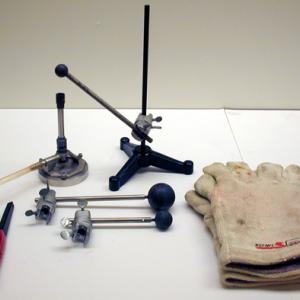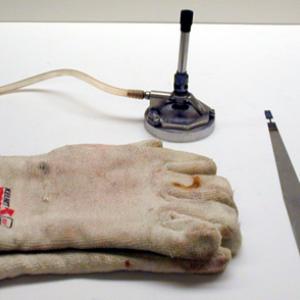College of Liberal Arts & Sciences
8A70.80 - Red Hot Ball - Planetary Temperatures
This demonstration must be started about 10 to 15 minutes before the time to be shown. Heat the ball with the Bunsen burner until it reaches a visible red hot. Focus the camera onto the ball with the iris all the way open and the color balance set about halfway towards the red end. Shut off the room lights and remove the flame and observe the cooling process. Note the lines and spots that develop showing how the cooling rates differ in different region according to the structure and stresses on the sphere. When the ball is no longer glowing visibly it can be shown that there is still a great amount of radiating energy by touching an unlighted match to the ball and watching it burst into flames. The Oxy-Acetylene torch will heat the ball up much faster, however you must be careful as there is the danger of actually melting the ball.
The new CCD cameras are very IR sensitive. Even after the ball has quit visibly glowing in the dark room the CCD camera will be able to see the ball very well. We also have an infrared viewer that may be used for viewing the ball after it has stopped visibly glowing. The usual procedure is to set up both the visible video camera and the IR camera so that you can monitor the ball in the visible and IR simultaneously.
Take the metal strip and hold the end in a Bunsen burner until red hot. Turn out lights and let cool while observing visible radiation.
- Michael LoPresto, Nichole Hagoort, "Determining Planetary Temperatures with the Stefan-Boltzmann Law", TPT, # 2, p. 113, Feb. 2011.
- Raymond Pierrehumbert, "Infrared Radiation and Planetary Temperature", Physics Today, January 2011, p. 33.
Disclaimer: These demonstrations are provided only for illustrative use by persons affiliated with The University of Iowa and only under the direction of a trained instructor or physicist. The University of Iowa is not responsible for demonstrations performed by those using their own equipment or who choose to use this reference material for their own purpose. The demonstrations included here are within the public domain and can be found in materials contained in libraries, bookstores, and through electronic sources. Performing all or any portion of any of these demonstrations, with or without revisions not depicted here entails inherent risks. These risks include, without limitation, bodily injury (and possibly death), including risks to health that may be temporary or permanent and that may exacerbate a pre-existing medical condition; and property loss or damage. Anyone performing any part of these demonstrations, even with revisions, knowingly and voluntarily assumes all risks associated with them.

